than rail voltage
2. Because the controlled (output) power can be much more than the controlling (input) power
3. Providing the voltage (up to 18v) on the gate rises and falls quickly
4. The higher the resistance of a material,
5. When there is a potential difference (voltage) across the conductors, a static electric field develops across the dielectric
b. a transistor can amplify a signal.
c. the MOSFET turns ON
d. causing positive charge to collect on one plate and negative charge on the other plate
e. the more potential difference is required to maintain a current.
Có thể bạn quan tâm!
-
 Tiếng Anh chuyên ngành Nghề Điện tử công nghiệp - CĐ Công nghiệp và Thương mại - 9
Tiếng Anh chuyên ngành Nghề Điện tử công nghiệp - CĐ Công nghiệp và Thương mại - 9 -
 Tiếng Anh chuyên ngành Nghề Điện tử công nghiệp - CĐ Công nghiệp và Thương mại - 10
Tiếng Anh chuyên ngành Nghề Điện tử công nghiệp - CĐ Công nghiệp và Thương mại - 10 -
 Tiếng Anh chuyên ngành Nghề Điện tử công nghiệp - CĐ Công nghiệp và Thương mại - 11
Tiếng Anh chuyên ngành Nghề Điện tử công nghiệp - CĐ Công nghiệp và Thương mại - 11 -
 Tiếng Anh chuyên ngành Nghề Điện tử công nghiệp - CĐ Công nghiệp và Thương mại - 13
Tiếng Anh chuyên ngành Nghề Điện tử công nghiệp - CĐ Công nghiệp và Thương mại - 13 -
 Tiếng Anh chuyên ngành Nghề Điện tử công nghiệp - CĐ Công nghiệp và Thương mại - 14
Tiếng Anh chuyên ngành Nghề Điện tử công nghiệp - CĐ Công nghiệp và Thương mại - 14 -
 Tiếng Anh chuyên ngành Nghề Điện tử công nghiệp - CĐ Công nghiệp và Thương mại - 15
Tiếng Anh chuyên ngành Nghề Điện tử công nghiệp - CĐ Công nghiệp và Thương mại - 15
Xem toàn bộ 134 trang tài liệu này.
V. CONVERSATION
Mục tiêu: Hình thành kỹ năng giao tiếp cho người học để người học có tự tin giao tiếp trong môi trường làm việc.
Lisa: Hi, Oliver
Oliver: Hi, Lisa. How’s everything ? Lisa: Well. Thanks. How about you? Oliver: Fine, Thanks.
Lisa: Do you know when the capacitance is greatest?
Oliver: Yes, I do. when there is a narrow separation between large areas of conductor.
Lisa: Right. Can you tell me how many methods to mark the value?
Oliver: Yes, I can. There are some following main methods such as: value written “normally”, using the prefix as the decimal point, using a three digit code, and using a three-band colour code.
Lisa: Do you mind explaining what µF stands for?
Oliver: No, not at all. It stands for microFarad. Lisa: Thanks. It’s time I must go. See you again. Oliver: OK. See you.
Unit 6: Data transmission
Bài học này giúp cho người học có kiến thức và kỹ năng về anh ngữ để đọc hiểu cấu tạo, nguyên lý hoạt động của một số các thiết bị điện tử được dùng trong các mạch điện tử như bộ khuếch đại hoạt động, bộ định thời, bộ khuếch đại tranzito, bộ dao động, bộ biến đổi, đồng thời cung cấp cho người học vốn thuật ngữ tiếng Anh chuyên ngành để người học có thể sử dụng trong môi trường làm việc với doanh nghiệp nước ngoài và đọc các tài liệu tham khảo chuyên ngành điện bằng tiếng Anh.
Mục tiêu của bài học:
Sau khi học xong bài học này, sinh viên có khả năng sử dụng kiến thức và kỹ năng anh ngữ:
- Đọc hiểu được thông số kỹ thuật và các nguyên tắc hoạt động của
các thiết bị điện tử như bộ khuếch đại hoạt động, bộ định thời, bộ khuếch đại tranzito, bộ dao động, bộ biến đổi.
- Hiểu các từ vựng và phát âm chính xác các thuật ngữ chuyên ngành về điện, điện tử.
- Ứng dụng ba loại câu điều kiện trong tiếng Anh vào ngữ cảnh thực tế.
- Tự tin giao tiếp trong môi trường doanh nghiệp
Nội dung của bài học:
I. VOCABULARY
Mục tiêu: Cung cấp cho người học các từ vựng bằng tiếng Anh trong lĩnh vực cấu tạo và nguyên lí hoạt động của một số thiết bị điện tử để người học có thể đọc và hiểu được từ chuyên môn liên quan đến một số tài liệu trong lĩnh vực điện điện tử công nghiệp bằng tiếng Anh.
Solenoid (n) : Cuộn dây ruột gà Valve (n) : Van
Target (n) : Biển báo Manufacturer (n) : Nhà sản xuất Timer (n) : Rơ le thời gian Retentive (adj) : Giữ lại
Tick (v) : Đánh dấu Preset (v) : Chỉnh trước Increment (n) : Gia số Ladder (n) : Thang
DIGIT (n) : Hằng số Common-emitter : Bộ phát chung Configuration (n) : Sự lập trình
Oscillation (n) : Bộ dao động Fluctuation (n) : Sự dao động Detector (n) : Máy dò tìm Pendulum (n) : Con lắc Timepiece (n) : Bộ định thời Wireless (n) : Không dây Transmitter (n) : Máy phát Phase (n) : Pha
Howling (n) : Tiếng rít Frequency (n) : Tần số
Quartz (n) : Thạch anh
Crystal (n) : Tinh thể
Vibrate (v) : Rung
Bias (n) : Sai số, sự lệch Divider (n) : Bộ chia Base (n) : Cực, ba zơ Stabilise (v) : Ổn định Oscillator (n) : Bộ dao động
Adjustable (adj) : Có thể chỉnh sửa Regulator (n) : Bộ điều chỉnh LED (n) : Đi ốt phát quang
Filter (n) : Bộ lọc
Infinite (adj) : Vô cực, vô cùng
Mineral rock (n) : Đá khoáng Quadrant (adj) : Góc phần tư Inverter (n) : Biến tần Link (v) : Kết nối Regenerative (adj) : Tái sinh
Mode (n) : Kiểu, phương thức Comparator (n) : So sánh Instrument (n) : Dụng cụ
Quad (n) : Cáp chập bốn
Offset (n) : Độ lệch tâm Impedance (n) : Trở kháng
II. GRAMMAR
Mục tiêu: Cung cấp cho người học cấu trúc ngữ pháp về câu điều kiện trong tiếng Anh để người học có thể sử dụng trong quá trình viết hoặc giao tiếp trong công việc tại nơi làm việc hoặc trong đồi sống hằng ngày có liên quan.
2.1 The Conditional Sentences
*Conditional Sentence Type 1
→ It is possible and also very likely that the condition will be fulfilled.
If + Simple Present, will-Future
Example: If I find her address, I’ll send her an invitation.
*Conditional Sentence Type 2
→ It is possible but very unlikely, that the condition will be fulfilled.
If + Simple Past, Conditional I (= would + Infinitive)
Form:
Example: If I found her address, I would send her an invitation.
*Conditional Sentence Type 3
→ It is impossible that the condition will be fulfilled because it refers to the
past.
If + Past Perfect, Conditional II (= would + have + Past Participle)
Example: If I had found her address, I would have sent her an invitation.
2.2 Exercise
a. Complete the Conditional Sentences Type I.
1. If Caroline and Sue…………. the salad, Phil…………. the house.
2. If Sue………….. the onions for the salad, Caroline……………….. the mushrooms.
3. Jane…………. the sitting room if Aaron and Tim……………….. the furniture.
4. If Bob……………… up the kitchen, Anita………….. the toilet.
5. Elaine………………. the drinks if somebody……………………. her carry the bottles.
6. If Alan and Rebecca…………….. the food, Mary and Conor…………… the sandwiches.
7. If Bob…………… after the barbecue, Sue…………….. the guests in.
8. Frank………………the DJ if the others……………… along their CDs.
9. Alan……………… the drinks if Jane……………… him some of her cocktail recipes.
10.If they……………. all their best, the party……………. great.
b. Complete the Conditional Sentences Type II.
1. If I…………… the lottery, I………………… a chance to hit the jackpot.
2. If I………………. the jackpot, I………………. rich.
3. If I……………….. rich, my life……………… completely.
4. I……………. a lonely island, if I……………. a nice one.
5. If I………………….. a lonely island, I………………. a huge house by the beach.
6. I……………….. all my friends if I………………….. a house by the beach.
7. I…………… my friends up in my yacht if they …………….to spend their holidays on my island.
8. We………… great parties if my friends………………. to my island.
9. If we……………….. to go shopping in a big city, we…………….. a helicopter.
10.But if my friends' holidays………… over, I………… very lonely on my lonely island.
c. Complete the Conditional Sentences Type III.
1. If the midfielders………. the ball more exactly, our team………. more chances to attack.
2. If the forwards……………. faster, they …………………..more goals.
3. Their motivation………………… if they…………… a goal during the first half.
4. The fullbacks……………… one or the other goal if they……………… their opponents.
5. If ………………the goalie up, he…………………… the ball.
6. If the referee……………….. the foul, he……………… a penalty kick to our team.
7. Our team……………….. in better form if they……………… harder the weeks before.
8. The game………….. better if the trainer………………. a substitute in during the second half.
9. If it…………….. a home game, our team………………… the match.
10. If our team…………………….. the match, they…………………….. up in the league.
III. CONTENT
Mục tiêu: Hình thành kiến thức và kỹ đọc hiểu cho người học để người học có thể đọc được một số tài liệu liên quan đến một số các thiết bị điện tử bằng tiếng Anh.
1. Operational Amplifiers
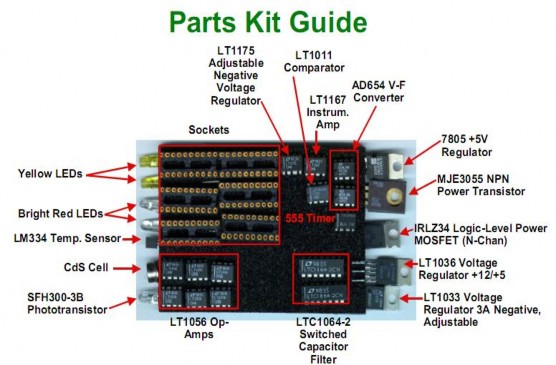
Types of Op-Amps
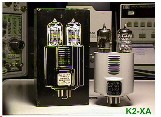
•Low power • Low noise
• Low offset • High power
• High voltage • High speed
• Single • Dual
• Quad
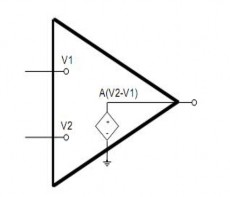
The Ideal Op-Amp
1) The input impedance is infinite - i.e. no current ever flows into either input of the op-amp.
2) The output impedance is zero - i.e. the op-amp can drive any load impedance to any voltage.
3) The open-loop gain (A) is infinte.
4) The bandwidth is infinite.
5) The output voltage is zero when the input voltage difference is zero.
WHAT CAN YOU DO WITH OP-AMPS?
• Feed the hungry.

• Amplify signals.
Heal the sick
• Save the dolphins.
• Differentiate signals.
• Integrate s
•• ooff
ddee
ignals
Pay f the ficit.
• Buffer signals.
• End global warming.
• Sum multiple signals.
• Make music very loud!
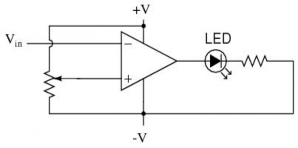
In the above circuit, we have an op-amp connected as a comparator, comparing the input voltage with a reference voltage set by the potentiometer (R1). If Vin drops below the voltage set by R1, the op-amp's output will saturate
to +V, thereby lighting up the LED. Otherwise, if Vin is above the reference voltage, the LED will remain off. If Vin is a voltage signal produced by a measuring instrument, this comparator circuit could function as a "low" alarm, with the trip-point set by R1. Instead of an LED, the op-amp output could drive a relay, a transistor, an SCR, or any other device capable of switching power to a load such as a solenoid valve, to take action in the event of a low alarm.
2. Timer
On-Delay timer: This type of timer simply “delays turning on”. In other words, after our sensor (input) turns on we wait x-seconds before activating a solenoid valve (output). This is the most common timer. It is often called TON (timer on-delay), TIM (timer) or TMR (timer).
Off-Delay timer: This type of timer is the opposite of the on-delay timer listed above. This timer simply "delays turning off". After our sensor (input) sees a target we turn on a solenoid (output). When the sensor no longer sees the target we hold the solenoid on for x-seconds before turning it off. It is called a TOF (timer off-delay) and is less common than the on-delay type listed above. (i.e. few manufacturers include this type of timer)
Retentive or Accumulating timer: This type of timer needs 2 inputs. One input starts the timing event (i.e. the clock starts ticking) and the other resets it. The on/off delay timers above would be reset if the input sensor wasn't on/off for the complete timer duration. This timer however holds or retains the current elapsed time when the sensor turns off in mid-stream. For example, we want to know how long a sensor is on for during a 1 hour period. If we use one of the above timers they will keep resetting when the sensor turns off/on. This timer however, will give us a total or accumulated time. It is often called an RTO (retentive timer) or TMRA (accumulating timer).

This timer is the on-delay type and is named Txxx. When the enable input is on the timer starts to tick. When it ticks yyyyy (the preset value) times, it will turn on its contacts that we will use later in the program. Remember that the duration of a tick (increment) varies with the vendor and the timebase used. (i.e. a tick might be 1ms or 1 second)
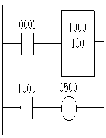

In this diagram we wait for input 0001 to turn on. When it does, timer T000 (a 100ms increment timer) starts ticking. It will tick 100 times. Each tick (increment) is 100ms so the timer will be a 10000ms (i.e. 10 second) timer. 100ticks X 100ms = 10,000ms. When 10 seconds have elapsed, the T000 contacts close and 500 turns on. When input 0001 turns off(false) the timer T000 will reset back to 0 causing its contacts to turn off(become false) thereby making output 500 turn back off.
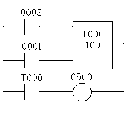
This timer is named Txxx. When the enable input is on the timer starts to tick. When it ticks yyyyy (the preset value) times, it will turn on its contacts that we will use later in the program. Remember that the duration of a tick (increment) varies with the vendor and the timebase used. (i.e. a tick might be 1ms or 1 second or...) If however, the enable input turns off before the timer has completed, the current value will be retained. When the input turns back on, the timer will continue from where it left off. The only way to force the timer back to its preset value to start again is to turn on the reset input.
In this diagram we wait for input 0002 to turn on. When it does timer T000 (a 10ms increment timer) starts ticking. It will tick 100 times. Each tick (increment) is 10ms so the timer will be a 1000ms (i.e. 1 second) timer. 100ticks X 10ms = 1,000ms. When 1 second has elapsed, the T000 contacts close and 500 turns on. If input 0002 turns back off the current elapsed time will be retained. When 0002 turns back on the timer will continue where it left off. When input 0001 turns on (true) the timer T000 will reset back to 0 causing its contacts to turn off (become false) thereby making output 500 turn back off.
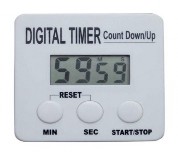
99 Minutes On/ Off Timer 20 Minute Timer
Timer 5 Minute to 50 Minute (10 Step)
Timer 2 Minute to 20 Minute (10 Step)
2 Digit Timer (0 to 99 Hours)






